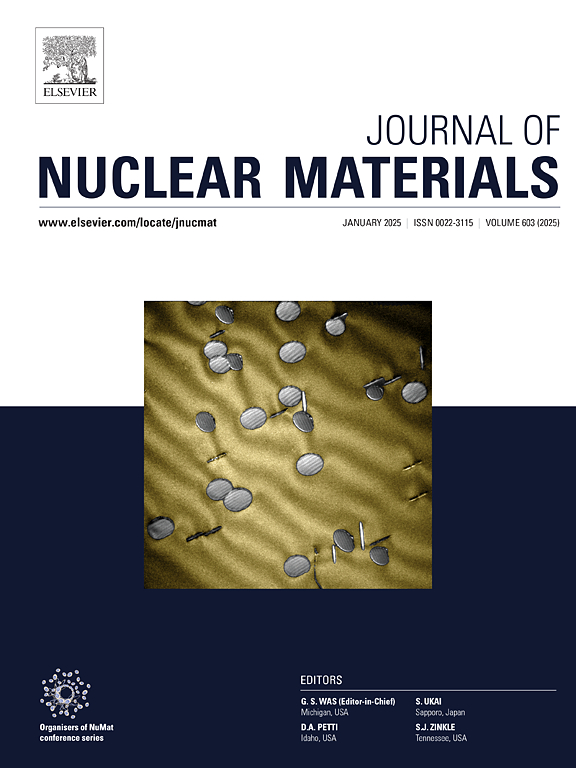在700℃质子和质子+氦辐照下,析出于铬合金800H中
IF 2.8
2区 工程技术
Q3 MATERIALS SCIENCE, MULTIDISCIPLINARY
引用次数: 0
摘要
利用透射电子显微镜(TEM)和能量色散x射线能谱仪(EDS)研究了质子辐照和氦注入后incoly 800H中的析出行为。在参比样品和辐照样品中均观察到长针状的TiC沉淀,在高剂量区域其大小逐渐减小。质子辐照形成了核壳结构的TiC-Ni₃Al相,其中Ni和Al在tic -基体界面富集。随后的氦气注入似乎进一步促进了这一现象。在质子辐照和氦注入样品中鉴定出两种类型的γ′(Ni₃(Al,Ti,Si))沉淀:(i)与氦气泡和位错相关的大的不规则沉淀;(ii)较小的球形γ′沉淀(直径约6.5 nm)均匀地存在于基体中。位错和tic -基体界面是γ′的主要成核点,其中氦泡优先成核。观察到的相稳定性表明,在辐射诱导溶解和辐射增强扩散之间存在平衡,高界面能位点在促进沉淀中起关键作用。这些发现为Fe-Ni-Cr基合金在辐照下的显微组织演变提供了有价值的见解。本文章由计算机程序翻译,如有差异,请以英文原文为准。
Precipitates in Incoloy 800H under proton and proton + helium irradiation at 700°C
The precipitation behavior in Incoloy 800H subjected to proton irradiation and helium implantation was investigated using transmission electron microscopy (TEM) along with energy-dispersive X-ray spectroscopy (EDS). Long, needle-like TiC precipitates were observed in both the reference and irradiated samples, with their size decreasing in high dose regions. Proton irradiation led to the formation of core-shell structured TiC-Ni₃Al precipitates, where Ni and Al enrichment occurred at TiC-matrix interfaces. Subsequent helium implantation seems to further promote this phenomenon. Two types of γ' (Ni₃(Al,Ti,Si)) precipitates were identified in the proton irradiated and helium implanted sample: (i) large, irregular precipitates associated with helium bubbles and dislocations, and (ii) smaller, spherical γ' precipitates (∼6.5 nm in diameter) homogeneously present in the matrix. Dislocations and TiC-matrix interfaces, where helium bubbles preferentially nucleated at, served as primary nucleation sites for γ'. The observed phase stability suggests a balance between radiation-induced dissolution and irradiation-enhanced diffusion, with high interfacial energy sites playing a key role in promoting precipitation. These findings provide valuable insights into the microstructural evolution of Fe-Ni-Cr based alloys under irradiation.
求助全文
通过发布文献求助,成功后即可免费获取论文全文。
去求助
来源期刊

Journal of Nuclear Materials
工程技术-材料科学:综合
CiteScore
5.70
自引率
25.80%
发文量
601
审稿时长
63 days
期刊介绍:
The Journal of Nuclear Materials publishes high quality papers in materials research for nuclear applications, primarily fission reactors, fusion reactors, and similar environments including radiation areas of charged particle accelerators. Both original research and critical review papers covering experimental, theoretical, and computational aspects of either fundamental or applied nature are welcome.
The breadth of the field is such that a wide range of processes and properties in the field of materials science and engineering is of interest to the readership, spanning atom-scale processes, microstructures, thermodynamics, mechanical properties, physical properties, and corrosion, for example.
Topics covered by JNM
Fission reactor materials, including fuels, cladding, core structures, pressure vessels, coolant interactions with materials, moderator and control components, fission product behavior.
Materials aspects of the entire fuel cycle.
Materials aspects of the actinides and their compounds.
Performance of nuclear waste materials; materials aspects of the immobilization of wastes.
Fusion reactor materials, including first walls, blankets, insulators and magnets.
Neutron and charged particle radiation effects in materials, including defects, transmutations, microstructures, phase changes and macroscopic properties.
Interaction of plasmas, ion beams, electron beams and electromagnetic radiation with materials relevant to nuclear systems.
 求助内容:
求助内容: 应助结果提醒方式:
应助结果提醒方式:


